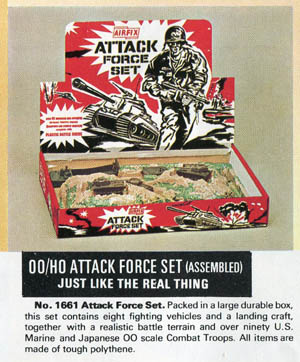 |
| Left to right: a D&D 32mm cultist, Sven and another 1/72 figure, a Star Wars MicroMachine ( |
In Britain, though, they had a bit of a problem. Their real-life trains were smaller than those in the U.S. or in Europe, such that if they wanted to build model trains in true HO scale, they would have to be physically smaller than what was possible at the time. Their solution was sort of odd: they used HO scale tracks and wheel spacing, but they put larger scale cabs and cars on top of these. Buildings, figures, and other scenery were also in this larger scale. They called this scale OO, which like HO also essentially means half-O, and which is defined as 1/76 scale. (Astute readers will note that having different scales for the wheels and cabs means that OO scale is not really proportional to real-life trains, and indeed OO trains do have sort of a chunky look.)
Maybe you can see where the seeds of confusion sprung. In the sense that HO and OO models can run on the same track, one could say that the two scales are compatible. And in the sense that 1/76 is really similar in size to 1/72, which was already being used for military models, one could say that those two scales are also compatible. But it's a category error to say these two different senses are the same sense, if you follow me. Nonetheless, if OO scale was said to be compatible with both HO and 1/72 scale, if in different ways, it was only a matter of time before someone made the mistake of claiming that HO and 1/72 were compatible as well.
I have know direct knowledge of this, but I suspect that someone was Airfix, for a few reasons. Airfix was a British company and would have been more exposed to OO scale than, say, Atlantic or Revell. They were around when these new model railroad scales were gaining popularity. And they actually put "HO OO scale" as a description on their old boxes, which reveals that they thought the two scales were compatible in size—entirely incorrect, as we have seen.
 |
| Pic credit: Plastic Soldier Review |

Way back in the day when virtually all that was to be had was Airfix and then along came Atlantic and thier Claim to being HO. My suprise when I opened a box of ancient egyptians!!
ReplyDeleteThe actual heights of bods is bad enough but then add the shapes/styles. Even within one Company they differ..the late romans from HaT The heavy infantry..finely sculpted ..the meduim inf chunky
I've thought myself that Airfix might be to blame for a good amount of the confusion. I have several of their sets, and I really like them, but they are almost comically small compared to 'true' 1/72 miniatures.
ReplyDeleteI've heard some people attribute it to a gradual 'scale creep', where manufacturers slightly enlarged pieces to get better detail, but I'm not entirely convinced. Even the older Revell sets tower above their Airfix counterparts.
I've often wondered if Airfix models are able to be called 1/72, or are really closer to OO 1/76 scale.